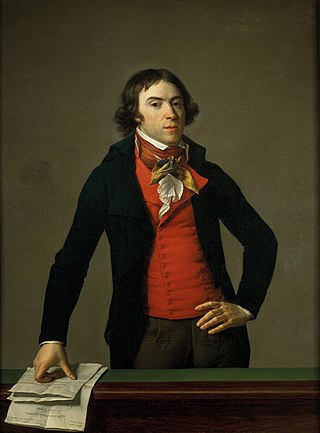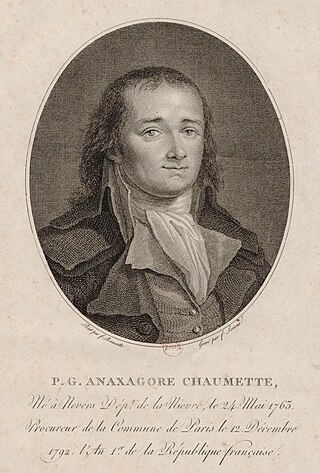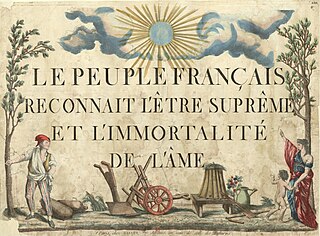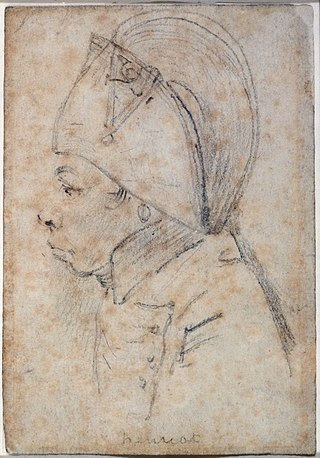
The French Revolution was a period of political and societal change in France that began with the Estates General of 1789, and ended with the coup of 18 Brumaire on November 1799 and the formation of the French Consulate. Many of its ideas are considered fundamental principles of liberal democracy, while its values and institutions remain central to modern French political discourse.

The Reign of Terror was a period of the French Revolution when, following the creation of the First Republic, a series of massacres and numerous public executions took place in response to revolutionary fervour, anticlerical sentiment, and accusations of treason by the Committee of Public Safety.

Bertrand Barère de Vieuzac was a French politician, freemason, journalist, and one of the most prominent members of the National Convention, representing the Plain during the French Revolution. The Plain was dominated by the radical Montagnards and Barère as one of their leaders supported the foundation of the Committee of Public Safety in April and of a sans-culottes army in September 1793. According to Francois Buzot, Barère was responsible for the Reign of Terror, like Robespierre and Louis de Saint-Just. In Spring 1794 and after the Festival of the Supreme Being, he became an opponent of Maximilien Robespierre and joined the coup, leading to his downfall.

The Society of the Friends of the Constitution, renamed the Society of the Jacobins, Friends of Freedom and Equality after 1792 and commonly known as the Jacobin Club or simply the Jacobins, was the most influential political club during the French Revolution of 1789. The period of its political ascendancy includes the Reign of Terror, during which well over 10,000 people were put on trial and executed in France, many for political crimes.

The Girondins, or Girondists, were a political group during the French Revolution. From 1791 to 1793, the Girondins were active in the Legislative Assembly and the National Convention. Together with the Montagnards, they initially were part of the Jacobin movement. They campaigned for the end of the monarchy, but then resisted the spiraling momentum of the Revolution, which caused a conflict with the more radical Montagnards. They dominated the movement until their fall in the insurrection of 31 May – 2 June 1793, which resulted in the domination of the Montagnards and the purge and eventual mass execution of the Girondins. This event is considered to mark the beginning of the Reign of Terror.

Pierre Gaspard Anaxagore Chaumette was a French politician of the Revolutionary period who served as the president of the Paris Commune and played a leading role in the establishment of the Reign of Terror. He was one of the ultra-radical enragés of the revolution, an ardent critic of Christianity who was one of the leaders of the dechristianization of France. His radical positions resulted in his alienation from Maximilien Robespierre, and he was arrested on charges of execution.

The Mountain was a political group during the French Revolution. Its members, called the Montagnards, sat on the highest benches in the National Convention. The term, first used during a session of the Legislative Assembly, came into general use in 1793. By the summer of 1793, that pair of opposed minority groups divided the National Convention. That year, the Montagnards were influential in what is commonly known as the Reign of Terror.

The sans-culottes were the common people of the lower classes in late 18th-century France, a great many of whom became radical and militant partisans of the French Revolution in response to their poor quality of life under the Ancien Régime. The word sans-culotte, which is opposed to "aristocrat", seems to have been used for the first time on 28 February 1791 by Jean-Bernard Gauthier de Murnan in a derogatory sense, speaking about a "sans-culottes army". The word came into vogue during the demonstration of 20 June 1792.

Jacques René Hébert was a French journalist and the founder and editor of the extreme radical newspaper Le Père Duchesne during the French Revolution.

Georges Auguste Couthon was a French politician and lawyer known for his service as a deputy in the Legislative Assembly during the French Revolution. Couthon was elected to the Committee of Public Safety on 30 May 1793. Along with his close associates, Maximilien Robespierre and Louis Antoine de Saint-Just, he formed an unofficial triumvirate within the committee which wielded power until their arrest and execution in 1794 during the period of the Reign of Terror. A Freemason, Couthon played an important role in the development of the Law of 22 Prairial, which was responsible for a sharp increase in the number of executions of accused counter-revolutionaries.

Jean-Baptiste-Joseph Gobel was a French Catholic cleric and politician of the Revolution. He was executed during the Reign of Terror.

The Cult of the Supreme Being was a form of deism established in France by Maximilien Robespierre during the French Revolution. It was intended to become the state religion of the new French Republic and a replacement for Roman Catholicism and its rival, the Cult of Reason. It went unsupported after the fall of Robespierre and, along with the Cult of Reason, was officially banned by First Consul Napoleon Bonaparte in 1802.

François Hanriot was a French Sans-culotte leader, street orator, and commander of the Garde Nationale during the French Revolution. He played a vital role in the Insurrection of 31 May – 2 June 1793 and subsequently the fall of the Girondins. On 27 July 1794 he tried to release Maximilien Robespierre, who was arrested by the Convention. He was executed on the next day – together with Robespierre, Saint-Just and Couthon – by the rules of the law of 22 Prairial, only verifying his identity at the trial.
The Hébertists, or Exaggerators were a radical revolutionary political group associated with the populist journalist Jacques Hébert, a member of the Cordeliers club. They came to power during the Reign of Terror and played a significant role in the French Revolution.
The aim of a number of separate policies conducted by various governments of France during the French Revolution ranged from the appropriation by the government of the great landed estates and the large amounts of money held by the Catholic Church to the termination of Christian religious practice and of the religion itself. There has been much scholarly debate over whether the movement was popularly motivated or motivated by a small group of revolutionary radicals. These policies, which ended with the Concordat of 1801, formed the basis of the later and less radical laïcité policies.

Charles-Philippe Ronsin was a French general of the Revolutionary Army of the First French Republic, commanding the large Parisian division of l'Armée Révolutionnaire. He was an extreme radical leader of the French Revolution, and one of the many followers of Jacques-René Hébert, known as the Hébertists.

François-Nicolas Vincent was the Secretary General of the War Ministry in the First French Republic, and a significant figure in the French Revolution. A member of the Cordelier Club, he is best known as a radical sans-culottes leader and prominent member of the Hébertist faction.

Antoine-François Momoro was a French printer, bookseller and politician during the French Revolution. An important figure in the Cordeliers club and in Hébertisme, he is the originator of the phrase ″Unité, Indivisibilité de la République; Liberté, égalité, fraternité ou la mort″, one of the mottoes of the French Republic.

Maximilien François Marie Isidore de Robespierre was a prominent French lawyer and statesman, widely recognized as one of the most influential, and controversial figures of the French Revolution. Robespierre played a pivotal role in the events that led to the downfall of the French monarchy on 10 August 1792 and the subsequent convening of the National Convention. His vision was centered on forging a unified and indivisible France, establishing equality under the law, eradicating prerogatives, and staunchly upholding the principles of direct democracy.

Irreligion in France has a long history and a large demographic constitution, with the advancement of atheism and the deprecation of theistic religion dating back as far as the French Revolution. In 2015, according to estimates, at least 29% of the country's population identifies as atheists and 63% identifies as non-religious.






















